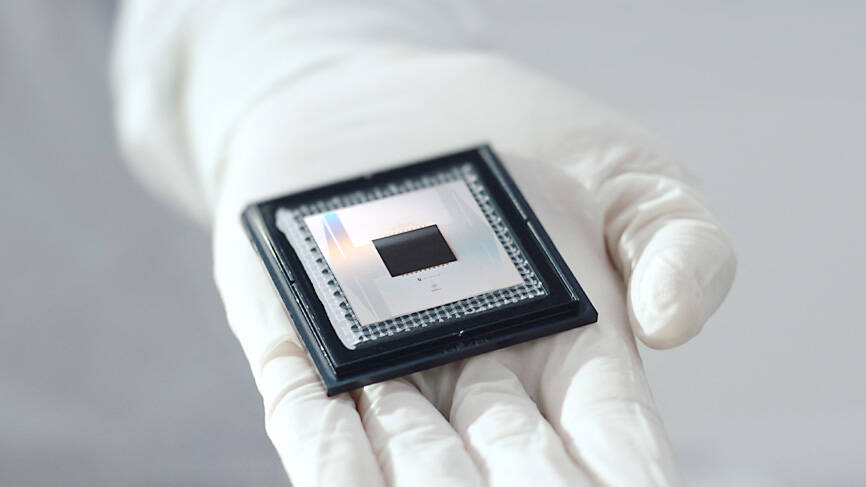Google on Monday showed off a new quantum computing chip that it said was a breakthrough that could bring practical quantum computing closer to reality.
A custom chip called “Willow” does in minutes what it would take leading supercomputers 10 septillion years to complete, Google Quantum AI (artificial intelligence) founder Hartmut Neven said.
“Written out, there is a 1 with 25 zeros,” Neven said of the time span while briefing journalists.

Photo: AFP via Google
“A mind-boggling number,” Neven added.
Neven’s team of about 300 people at Google is on a mission to build quantum computing capable of handling otherwise unsolvable problems like safe fusion power and stopping climate change.
“We see Willow as an important step in our journey to build a useful quantum computer with practical applications in areas like drug discovery, fusion energy, battery design and more,” Google CEO Sundar Pichai said on X.
A quantum computer that can tackle these challenges is still years away, but Willow marks a significant step in that direction, Google said.
While still in its early stages, scientists believe that superfast quantum computing would eventually be able to power innovation in a range of fields.
Quantum research is seen as a critical field and the US and China have been investing heavily in the area, while Washington has also placed restrictions on the export of the sensitive technology.
Private and public investment in the field has totaled about US$20 billion worldwide over the past five years, Olivier Ezratty, an independent expert in quantum technologies, said in October.
Regular computers function in binary fashion: They carry out tasks using tiny fragments of data known as bits that are only ever either expressed as 1 or 0.
However, fragments of data on a quantum computer, known as qubits, can be 1 and 0 at the same time — allowing them to crunch an enormous number of potential outcomes simultaneously.
Crucially, Google’s chip demonstrated the ability to reduce computational errors exponentially as it scales up — a feat that has eluded researchers for about 30 years.
The breakthrough in error correction, published in leading science journal Nature, showed that adding more qubits to the system reduced errors rather than increasing them — a fundamental requirement for building practical quantum computers.
Error correction is the “end game” in quantum computing and Google is “confidently progressing” along the path, Google quantum hardware director Julian Kelly said.

Taiwan Semiconductor Manufacturing Co (TSMC, 台積電) would not produce its most advanced technologies in the US next year, Minister of Economic Affairs J.W. Kuo (郭智輝) said yesterday. Kuo made the comment during an appearance at the legislature, hours after the chipmaker announced that it would invest an additional US$100 billion to expand its manufacturing operations in the US. Asked by Taiwan People’s Party Legislator-at-large Chang Chi-kai (張啟楷) if TSMC would allow its most advanced technologies, the yet-to-be-released 2-nanometer and 1.6-nanometer processes, to go to the US in the near term, Kuo denied it. TSMC recently opened its first US factory, which produces 4-nanometer

PROTECTION: The investigation, which takes aim at exporters such as Canada, Germany and Brazil, came days after Trump unveiled tariff hikes on steel and aluminum products US President Donald Trump on Saturday ordered a probe into potential tariffs on lumber imports — a move threatening to stoke trade tensions — while also pushing for a domestic supply boost. Trump signed an executive order instructing US Secretary of Commerce Howard Lutnick to begin an investigation “to determine the effects on the national security of imports of timber, lumber and their derivative products.” The study might result in new tariffs being imposed, which would pile on top of existing levies. The investigation takes aim at exporters like Canada, Germany and Brazil, with White House officials earlier accusing these economies of

Teleperformance SE, the largest call-center operator in the world, is rolling out an artificial intelligence (AI) system that softens English-speaking Indian workers’ accents in real time in a move the company claims would make them more understandable. The technology, called accent translation, coupled with background noise cancelation, is being deployed in call centers in India, where workers provide customer support to some of Teleperformance’s international clients. The company provides outsourced customer support and content moderation to global companies including Apple Inc, ByteDance Ltd’s (字節跳動) TikTok and Samsung Electronics Co Ltd. “When you have an Indian agent on the line, sometimes it’s hard

PROBE CONTINUES: Those accused falsely represented that the chips would not be transferred to a person other than the authorized end users, court papers said Singapore charged three men with fraud in a case local media have linked to the movement of Nvidia’s advanced chips from the city-state to Chinese artificial intelligence (AI) firm DeepSeek (深度求索). The US is investigating if DeepSeek, the Chinese company whose AI model’s performance rocked the tech world in January, has been using US chips that are not allowed to be shipped to China, Reuters reported earlier. The Singapore case is part of a broader police investigation of 22 individuals and companies suspected of false representation, amid concerns that organized AI chip smuggling to China has been tracked out of nations such